Critical Evaluation of Standard Precautions in Aged Care Settings
VerifiedAdded on 2022/12/28
|13
|4809
|86
Report
AI Summary
This report provides a critical evaluation of standard precautions in aged care settings, focusing on hand hygiene practices, the use of personal protective equipment (PPE), and strategies for infection control. The report begins by defining standard precautions and their importance in minimizing the risk of infection transmission, particularly in vulnerable populations. It then explores the background and context of the issue, highlighting the significance of hand hygiene as a key element in preventing healthcare-associated infections. The report examines factors influencing hand hygiene adherence, including barriers such as lack of knowledge, inadequate resources, and organizational culture. It proposes strategies for improving hand hygiene, such as education, product placement at the point of care, and the implementation of a hierarchy of controls. The report also discusses donning and doffing of PPE and emphasizes the need for support from higher authorities to implement effective hygiene strategies. Finally, the report emphasizes the importance of audit and feedback mechanisms to ensure compliance and improve outcomes in aged care settings.
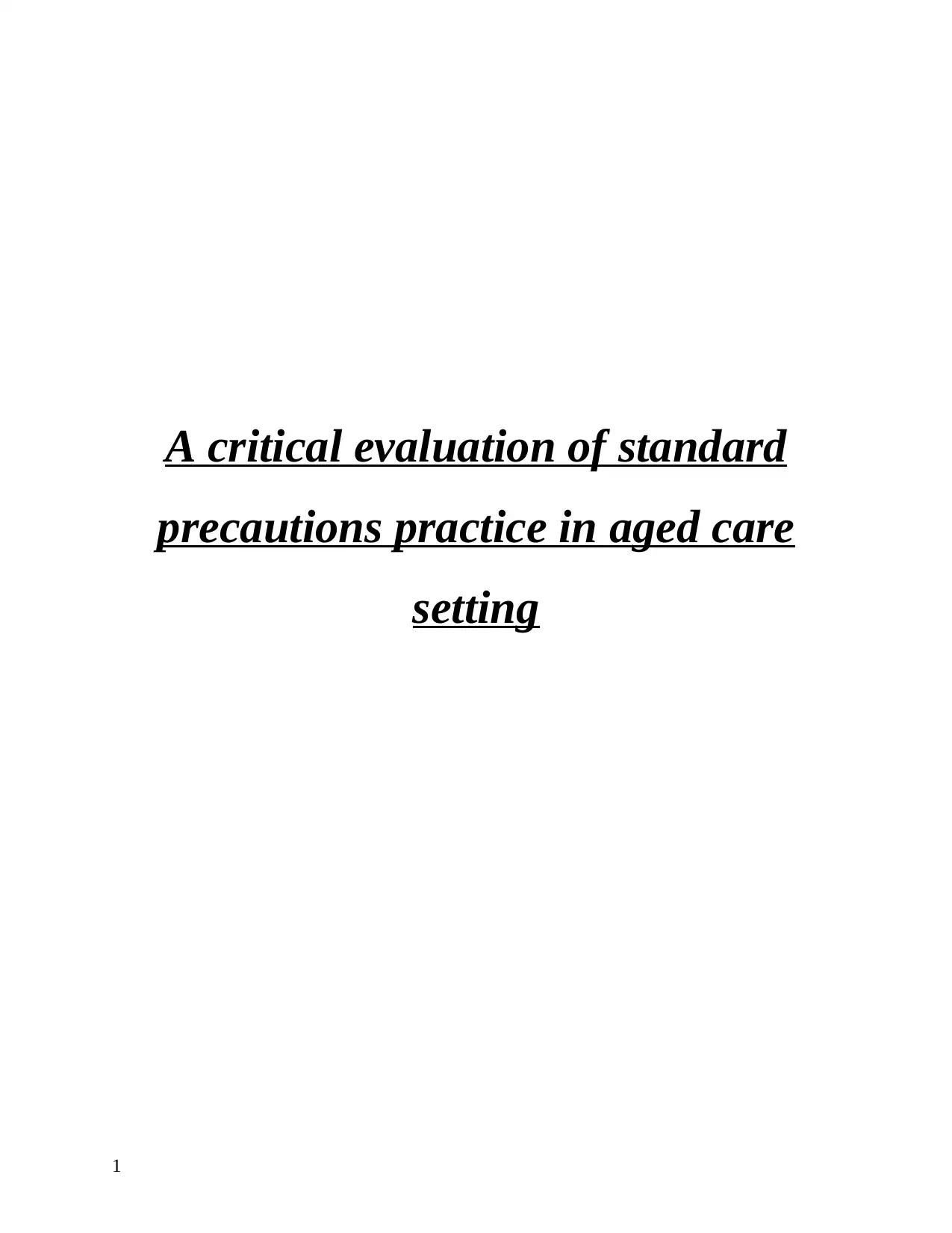
A critical evaluation of standard
precautions practice in aged care
setting
1
precautions practice in aged care
setting
1
Paraphrase This Document
Need a fresh take? Get an instant paraphrase of this document with our AI Paraphraser
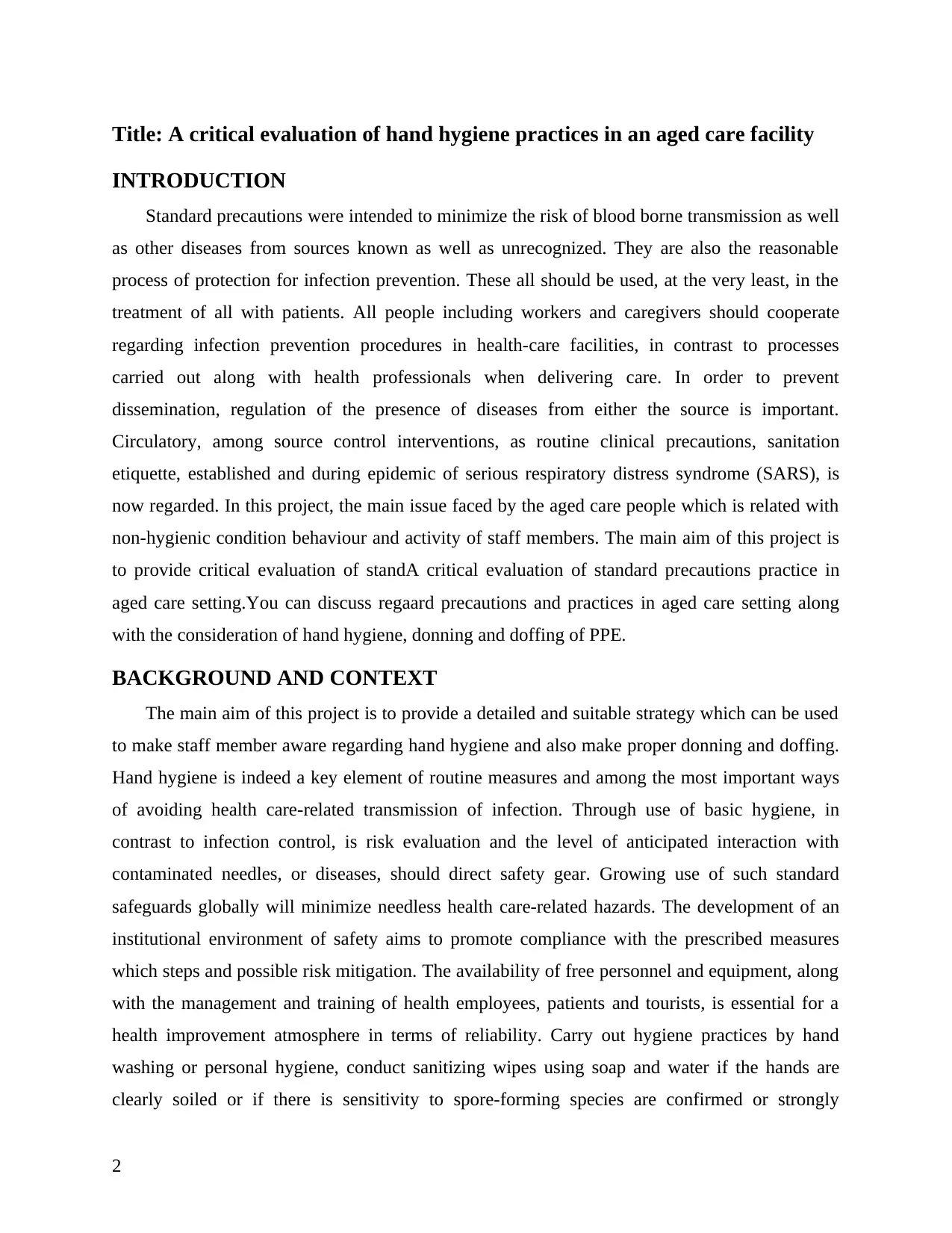
Title: A critical evaluation of hand hygiene practices in an aged care facility
INTRODUCTION
Standard precautions were intended to minimize the risk of blood borne transmission as well
as other diseases from sources known as well as unrecognized. They are also the reasonable
process of protection for infection prevention. These all should be used, at the very least, in the
treatment of all with patients. All people including workers and caregivers should cooperate
regarding infection prevention procedures in health-care facilities, in contrast to processes
carried out along with health professionals when delivering care. In order to prevent
dissemination, regulation of the presence of diseases from either the source is important.
Circulatory, among source control interventions, as routine clinical precautions, sanitation
etiquette, established and during epidemic of serious respiratory distress syndrome (SARS), is
now regarded. In this project, the main issue faced by the aged care people which is related with
non-hygienic condition behaviour and activity of staff members. The main aim of this project is
to provide critical evaluation of standA critical evaluation of standard precautions practice in
aged care setting.You can discuss regaard precautions and practices in aged care setting along
with the consideration of hand hygiene, donning and doffing of PPE.
BACKGROUND AND CONTEXT
The main aim of this project is to provide a detailed and suitable strategy which can be used
to make staff member aware regarding hand hygiene and also make proper donning and doffing.
Hand hygiene is indeed a key element of routine measures and among the most important ways
of avoiding health care-related transmission of infection. Through use of basic hygiene, in
contrast to infection control, is risk evaluation and the level of anticipated interaction with
contaminated needles, or diseases, should direct safety gear. Growing use of such standard
safeguards globally will minimize needless health care-related hazards. The development of an
institutional environment of safety aims to promote compliance with the prescribed measures
which steps and possible risk mitigation. The availability of free personnel and equipment, along
with the management and training of health employees, patients and tourists, is essential for a
health improvement atmosphere in terms of reliability. Carry out hygiene practices by hand
washing or personal hygiene, conduct sanitizing wipes using soap and water if the hands are
clearly soiled or if there is sensitivity to spore-forming species are confirmed or strongly
2
INTRODUCTION
Standard precautions were intended to minimize the risk of blood borne transmission as well
as other diseases from sources known as well as unrecognized. They are also the reasonable
process of protection for infection prevention. These all should be used, at the very least, in the
treatment of all with patients. All people including workers and caregivers should cooperate
regarding infection prevention procedures in health-care facilities, in contrast to processes
carried out along with health professionals when delivering care. In order to prevent
dissemination, regulation of the presence of diseases from either the source is important.
Circulatory, among source control interventions, as routine clinical precautions, sanitation
etiquette, established and during epidemic of serious respiratory distress syndrome (SARS), is
now regarded. In this project, the main issue faced by the aged care people which is related with
non-hygienic condition behaviour and activity of staff members. The main aim of this project is
to provide critical evaluation of standA critical evaluation of standard precautions practice in
aged care setting.You can discuss regaard precautions and practices in aged care setting along
with the consideration of hand hygiene, donning and doffing of PPE.
BACKGROUND AND CONTEXT
The main aim of this project is to provide a detailed and suitable strategy which can be used
to make staff member aware regarding hand hygiene and also make proper donning and doffing.
Hand hygiene is indeed a key element of routine measures and among the most important ways
of avoiding health care-related transmission of infection. Through use of basic hygiene, in
contrast to infection control, is risk evaluation and the level of anticipated interaction with
contaminated needles, or diseases, should direct safety gear. Growing use of such standard
safeguards globally will minimize needless health care-related hazards. The development of an
institutional environment of safety aims to promote compliance with the prescribed measures
which steps and possible risk mitigation. The availability of free personnel and equipment, along
with the management and training of health employees, patients and tourists, is essential for a
health improvement atmosphere in terms of reliability. Carry out hygiene practices by hand
washing or personal hygiene, conduct sanitizing wipes using soap and water if the hands are
clearly soiled or if there is sensitivity to spore-forming species are confirmed or strongly
2
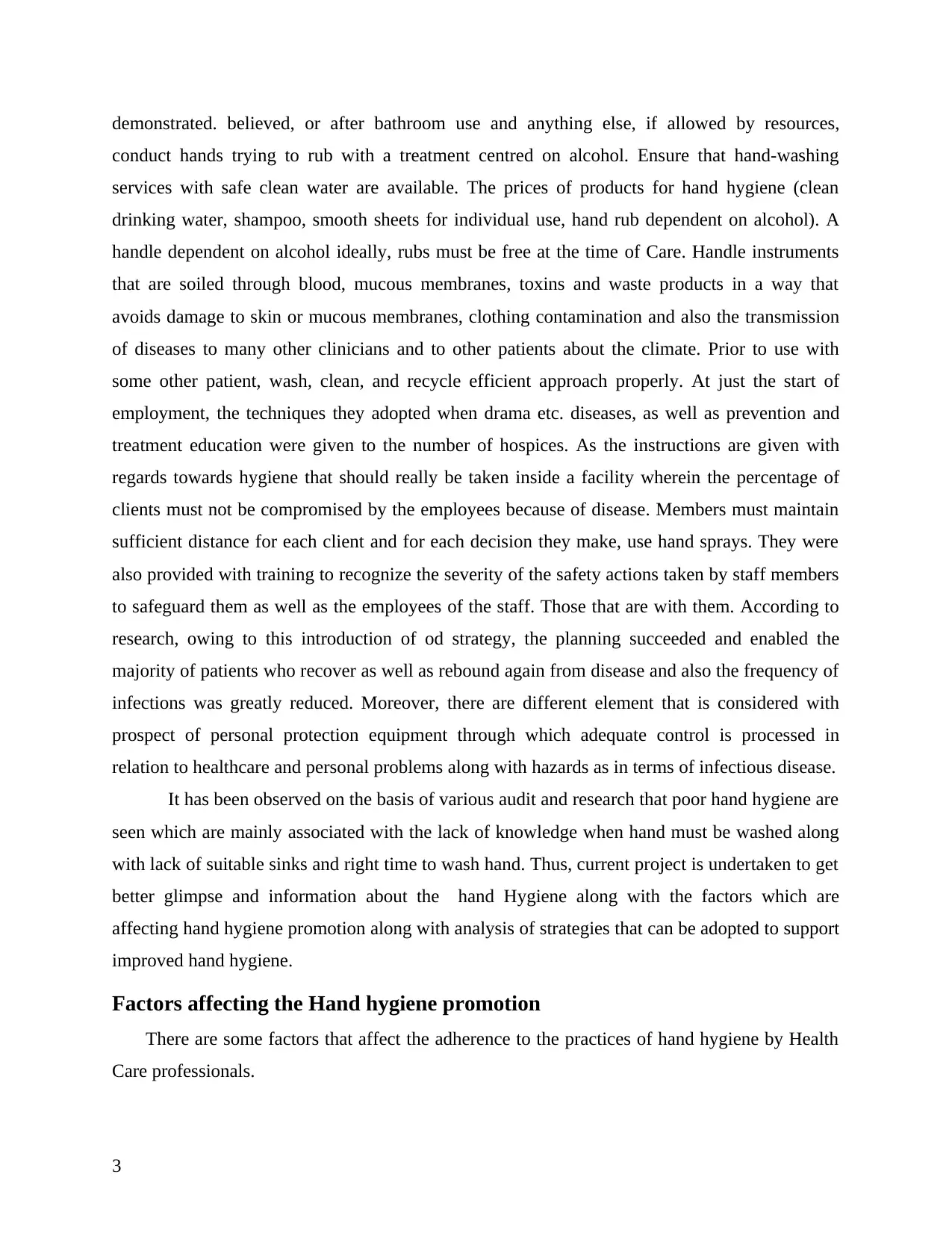
demonstrated. believed, or after bathroom use and anything else, if allowed by resources,
conduct hands trying to rub with a treatment centred on alcohol. Ensure that hand-washing
services with safe clean water are available. The prices of products for hand hygiene (clean
drinking water, shampoo, smooth sheets for individual use, hand rub dependent on alcohol). A
handle dependent on alcohol ideally, rubs must be free at the time of Care. Handle instruments
that are soiled through blood, mucous membranes, toxins and waste products in a way that
avoids damage to skin or mucous membranes, clothing contamination and also the transmission
of diseases to many other clinicians and to other patients about the climate. Prior to use with
some other patient, wash, clean, and recycle efficient approach properly. At just the start of
employment, the techniques they adopted when drama etc. diseases, as well as prevention and
treatment education were given to the number of hospices. As the instructions are given with
regards towards hygiene that should really be taken inside a facility wherein the percentage of
clients must not be compromised by the employees because of disease. Members must maintain
sufficient distance for each client and for each decision they make, use hand sprays. They were
also provided with training to recognize the severity of the safety actions taken by staff members
to safeguard them as well as the employees of the staff. Those that are with them. According to
research, owing to this introduction of od strategy, the planning succeeded and enabled the
majority of patients who recover as well as rebound again from disease and also the frequency of
infections was greatly reduced. Moreover, there are different element that is considered with
prospect of personal protection equipment through which adequate control is processed in
relation to healthcare and personal problems along with hazards as in terms of infectious disease.
It has been observed on the basis of various audit and research that poor hand hygiene are
seen which are mainly associated with the lack of knowledge when hand must be washed along
with lack of suitable sinks and right time to wash hand. Thus, current project is undertaken to get
better glimpse and information about the hand Hygiene along with the factors which are
affecting hand hygiene promotion along with analysis of strategies that can be adopted to support
improved hand hygiene.
Factors affecting the Hand hygiene promotion
There are some factors that affect the adherence to the practices of hand hygiene by Health
Care professionals.
3
conduct hands trying to rub with a treatment centred on alcohol. Ensure that hand-washing
services with safe clean water are available. The prices of products for hand hygiene (clean
drinking water, shampoo, smooth sheets for individual use, hand rub dependent on alcohol). A
handle dependent on alcohol ideally, rubs must be free at the time of Care. Handle instruments
that are soiled through blood, mucous membranes, toxins and waste products in a way that
avoids damage to skin or mucous membranes, clothing contamination and also the transmission
of diseases to many other clinicians and to other patients about the climate. Prior to use with
some other patient, wash, clean, and recycle efficient approach properly. At just the start of
employment, the techniques they adopted when drama etc. diseases, as well as prevention and
treatment education were given to the number of hospices. As the instructions are given with
regards towards hygiene that should really be taken inside a facility wherein the percentage of
clients must not be compromised by the employees because of disease. Members must maintain
sufficient distance for each client and for each decision they make, use hand sprays. They were
also provided with training to recognize the severity of the safety actions taken by staff members
to safeguard them as well as the employees of the staff. Those that are with them. According to
research, owing to this introduction of od strategy, the planning succeeded and enabled the
majority of patients who recover as well as rebound again from disease and also the frequency of
infections was greatly reduced. Moreover, there are different element that is considered with
prospect of personal protection equipment through which adequate control is processed in
relation to healthcare and personal problems along with hazards as in terms of infectious disease.
It has been observed on the basis of various audit and research that poor hand hygiene are
seen which are mainly associated with the lack of knowledge when hand must be washed along
with lack of suitable sinks and right time to wash hand. Thus, current project is undertaken to get
better glimpse and information about the hand Hygiene along with the factors which are
affecting hand hygiene promotion along with analysis of strategies that can be adopted to support
improved hand hygiene.
Factors affecting the Hand hygiene promotion
There are some factors that affect the adherence to the practices of hand hygiene by Health
Care professionals.
3
⊘ This is a preview!⊘
Do you want full access?
Subscribe today to unlock all pages.

Trusted by 1+ million students worldwide
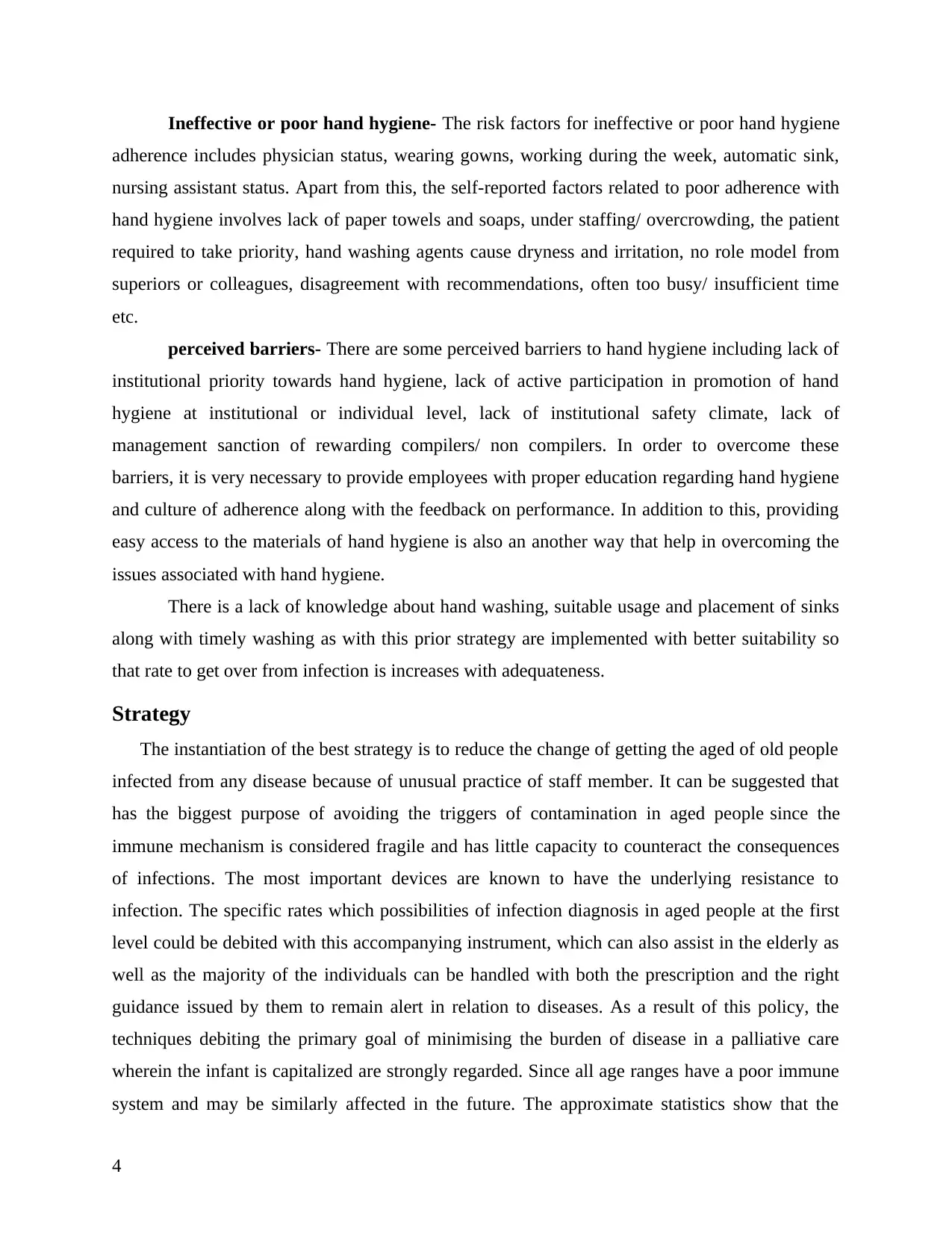
Ineffective or poor hand hygiene- The risk factors for ineffective or poor hand hygiene
adherence includes physician status, wearing gowns, working during the week, automatic sink,
nursing assistant status. Apart from this, the self-reported factors related to poor adherence with
hand hygiene involves lack of paper towels and soaps, under staffing/ overcrowding, the patient
required to take priority, hand washing agents cause dryness and irritation, no role model from
superiors or colleagues, disagreement with recommendations, often too busy/ insufficient time
etc.
perceived barriers- There are some perceived barriers to hand hygiene including lack of
institutional priority towards hand hygiene, lack of active participation in promotion of hand
hygiene at institutional or individual level, lack of institutional safety climate, lack of
management sanction of rewarding compilers/ non compilers. In order to overcome these
barriers, it is very necessary to provide employees with proper education regarding hand hygiene
and culture of adherence along with the feedback on performance. In addition to this, providing
easy access to the materials of hand hygiene is also an another way that help in overcoming the
issues associated with hand hygiene.
There is a lack of knowledge about hand washing, suitable usage and placement of sinks
along with timely washing as with this prior strategy are implemented with better suitability so
that rate to get over from infection is increases with adequateness.
Strategy
The instantiation of the best strategy is to reduce the change of getting the aged of old people
infected from any disease because of unusual practice of staff member. It can be suggested that
has the biggest purpose of avoiding the triggers of contamination in aged people since the
immune mechanism is considered fragile and has little capacity to counteract the consequences
of infections. The most important devices are known to have the underlying resistance to
infection. The specific rates which possibilities of infection diagnosis in aged people at the first
level could be debited with this accompanying instrument, which can also assist in the elderly as
well as the majority of the individuals can be handled with both the prescription and the right
guidance issued by them to remain alert in relation to diseases. As a result of this policy, the
techniques debiting the primary goal of minimising the burden of disease in a palliative care
wherein the infant is capitalized are strongly regarded. Since all age ranges have a poor immune
system and may be similarly affected in the future. The approximate statistics show that the
4
adherence includes physician status, wearing gowns, working during the week, automatic sink,
nursing assistant status. Apart from this, the self-reported factors related to poor adherence with
hand hygiene involves lack of paper towels and soaps, under staffing/ overcrowding, the patient
required to take priority, hand washing agents cause dryness and irritation, no role model from
superiors or colleagues, disagreement with recommendations, often too busy/ insufficient time
etc.
perceived barriers- There are some perceived barriers to hand hygiene including lack of
institutional priority towards hand hygiene, lack of active participation in promotion of hand
hygiene at institutional or individual level, lack of institutional safety climate, lack of
management sanction of rewarding compilers/ non compilers. In order to overcome these
barriers, it is very necessary to provide employees with proper education regarding hand hygiene
and culture of adherence along with the feedback on performance. In addition to this, providing
easy access to the materials of hand hygiene is also an another way that help in overcoming the
issues associated with hand hygiene.
There is a lack of knowledge about hand washing, suitable usage and placement of sinks
along with timely washing as with this prior strategy are implemented with better suitability so
that rate to get over from infection is increases with adequateness.
Strategy
The instantiation of the best strategy is to reduce the change of getting the aged of old people
infected from any disease because of unusual practice of staff member. It can be suggested that
has the biggest purpose of avoiding the triggers of contamination in aged people since the
immune mechanism is considered fragile and has little capacity to counteract the consequences
of infections. The most important devices are known to have the underlying resistance to
infection. The specific rates which possibilities of infection diagnosis in aged people at the first
level could be debited with this accompanying instrument, which can also assist in the elderly as
well as the majority of the individuals can be handled with both the prescription and the right
guidance issued by them to remain alert in relation to diseases. As a result of this policy, the
techniques debiting the primary goal of minimising the burden of disease in a palliative care
wherein the infant is capitalized are strongly regarded. Since all age ranges have a poor immune
system and may be similarly affected in the future. The approximate statistics show that the
4
Paraphrase This Document
Need a fresh take? Get an instant paraphrase of this document with our AI Paraphraser
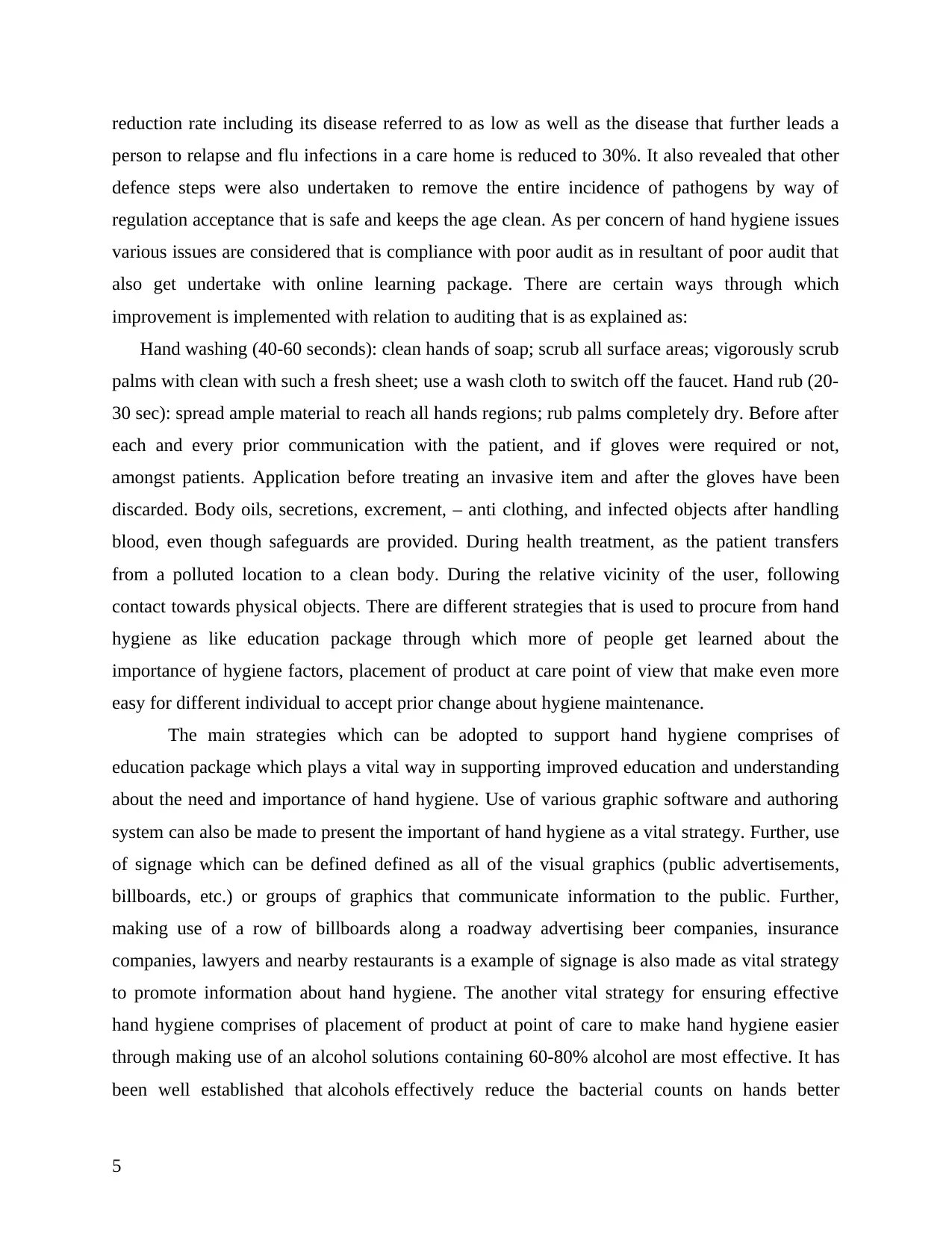
reduction rate including its disease referred to as low as well as the disease that further leads a
person to relapse and flu infections in a care home is reduced to 30%. It also revealed that other
defence steps were also undertaken to remove the entire incidence of pathogens by way of
regulation acceptance that is safe and keeps the age clean. As per concern of hand hygiene issues
various issues are considered that is compliance with poor audit as in resultant of poor audit that
also get undertake with online learning package. There are certain ways through which
improvement is implemented with relation to auditing that is as explained as:
Hand washing (40-60 seconds): clean hands of soap; scrub all surface areas; vigorously scrub
palms with clean with such a fresh sheet; use a wash cloth to switch off the faucet. Hand rub (20-
30 sec): spread ample material to reach all hands regions; rub palms completely dry. Before after
each and every prior communication with the patient, and if gloves were required or not,
amongst patients. Application before treating an invasive item and after the gloves have been
discarded. Body oils, secretions, excrement, – anti clothing, and infected objects after handling
blood, even though safeguards are provided. During health treatment, as the patient transfers
from a polluted location to a clean body. During the relative vicinity of the user, following
contact towards physical objects. There are different strategies that is used to procure from hand
hygiene as like education package through which more of people get learned about the
importance of hygiene factors, placement of product at care point of view that make even more
easy for different individual to accept prior change about hygiene maintenance.
The main strategies which can be adopted to support hand hygiene comprises of
education package which plays a vital way in supporting improved education and understanding
about the need and importance of hand hygiene. Use of various graphic software and authoring
system can also be made to present the important of hand hygiene as a vital strategy. Further, use
of signage which can be defined defined as all of the visual graphics (public advertisements,
billboards, etc.) or groups of graphics that communicate information to the public. Further,
making use of a row of billboards along a roadway advertising beer companies, insurance
companies, lawyers and nearby restaurants is a example of signage is also made as vital strategy
to promote information about hand hygiene. The another vital strategy for ensuring effective
hand hygiene comprises of placement of product at point of care to make hand hygiene easier
through making use of an alcohol solutions containing 60-80% alcohol are most effective. It has
been well established that alcohols effectively reduce the bacterial counts on hands better
5
person to relapse and flu infections in a care home is reduced to 30%. It also revealed that other
defence steps were also undertaken to remove the entire incidence of pathogens by way of
regulation acceptance that is safe and keeps the age clean. As per concern of hand hygiene issues
various issues are considered that is compliance with poor audit as in resultant of poor audit that
also get undertake with online learning package. There are certain ways through which
improvement is implemented with relation to auditing that is as explained as:
Hand washing (40-60 seconds): clean hands of soap; scrub all surface areas; vigorously scrub
palms with clean with such a fresh sheet; use a wash cloth to switch off the faucet. Hand rub (20-
30 sec): spread ample material to reach all hands regions; rub palms completely dry. Before after
each and every prior communication with the patient, and if gloves were required or not,
amongst patients. Application before treating an invasive item and after the gloves have been
discarded. Body oils, secretions, excrement, – anti clothing, and infected objects after handling
blood, even though safeguards are provided. During health treatment, as the patient transfers
from a polluted location to a clean body. During the relative vicinity of the user, following
contact towards physical objects. There are different strategies that is used to procure from hand
hygiene as like education package through which more of people get learned about the
importance of hygiene factors, placement of product at care point of view that make even more
easy for different individual to accept prior change about hygiene maintenance.
The main strategies which can be adopted to support hand hygiene comprises of
education package which plays a vital way in supporting improved education and understanding
about the need and importance of hand hygiene. Use of various graphic software and authoring
system can also be made to present the important of hand hygiene as a vital strategy. Further, use
of signage which can be defined defined as all of the visual graphics (public advertisements,
billboards, etc.) or groups of graphics that communicate information to the public. Further,
making use of a row of billboards along a roadway advertising beer companies, insurance
companies, lawyers and nearby restaurants is a example of signage is also made as vital strategy
to promote information about hand hygiene. The another vital strategy for ensuring effective
hand hygiene comprises of placement of product at point of care to make hand hygiene easier
through making use of an alcohol solutions containing 60-80% alcohol are most effective. It has
been well established that alcohols effectively reduce the bacterial counts on hands better
5
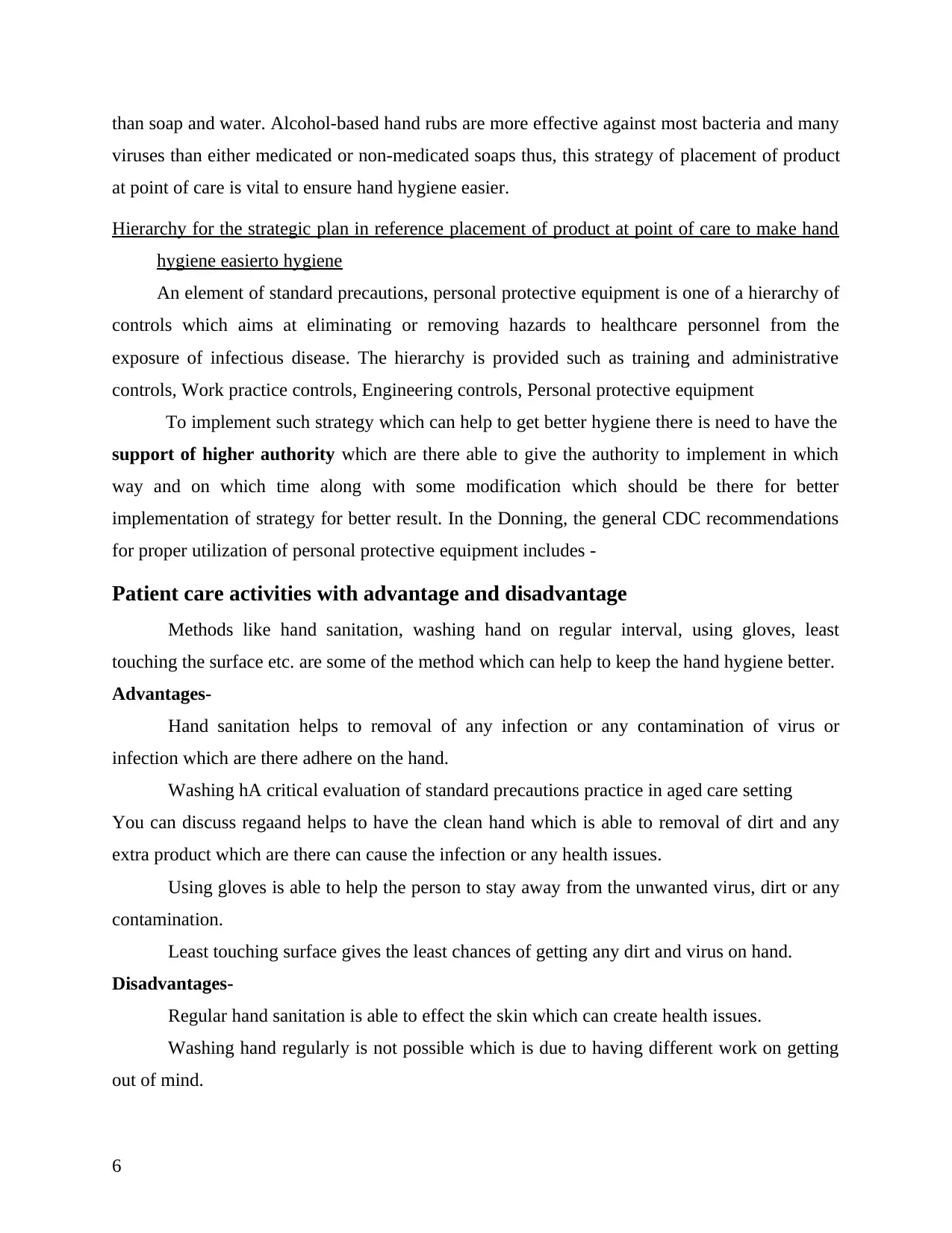
than soap and water. Alcohol-based hand rubs are more effective against most bacteria and many
viruses than either medicated or non-medicated soaps thus, this strategy of placement of product
at point of care is vital to ensure hand hygiene easier.
Hierarchy for the strategic plan in reference placement of product at point of care to make hand
hygiene easierto hygiene
An element of standard precautions, personal protective equipment is one of a hierarchy of
controls which aims at eliminating or removing hazards to healthcare personnel from the
exposure of infectious disease. The hierarchy is provided such as training and administrative
controls, Work practice controls, Engineering controls, Personal protective equipment
To implement such strategy which can help to get better hygiene there is need to have the
support of higher authority which are there able to give the authority to implement in which
way and on which time along with some modification which should be there for better
implementation of strategy for better result. In the Donning, the general CDC recommendations
for proper utilization of personal protective equipment includes -
Patient care activities with advantage and disadvantage
Methods like hand sanitation, washing hand on regular interval, using gloves, least
touching the surface etc. are some of the method which can help to keep the hand hygiene better.
Advantages-
Hand sanitation helps to removal of any infection or any contamination of virus or
infection which are there adhere on the hand.
Washing hA critical evaluation of standard precautions practice in aged care setting
You can discuss regaand helps to have the clean hand which is able to removal of dirt and any
extra product which are there can cause the infection or any health issues.
Using gloves is able to help the person to stay away from the unwanted virus, dirt or any
contamination.
Least touching surface gives the least chances of getting any dirt and virus on hand.
Disadvantages-
Regular hand sanitation is able to effect the skin which can create health issues.
Washing hand regularly is not possible which is due to having different work on getting
out of mind.
6
viruses than either medicated or non-medicated soaps thus, this strategy of placement of product
at point of care is vital to ensure hand hygiene easier.
Hierarchy for the strategic plan in reference placement of product at point of care to make hand
hygiene easierto hygiene
An element of standard precautions, personal protective equipment is one of a hierarchy of
controls which aims at eliminating or removing hazards to healthcare personnel from the
exposure of infectious disease. The hierarchy is provided such as training and administrative
controls, Work practice controls, Engineering controls, Personal protective equipment
To implement such strategy which can help to get better hygiene there is need to have the
support of higher authority which are there able to give the authority to implement in which
way and on which time along with some modification which should be there for better
implementation of strategy for better result. In the Donning, the general CDC recommendations
for proper utilization of personal protective equipment includes -
Patient care activities with advantage and disadvantage
Methods like hand sanitation, washing hand on regular interval, using gloves, least
touching the surface etc. are some of the method which can help to keep the hand hygiene better.
Advantages-
Hand sanitation helps to removal of any infection or any contamination of virus or
infection which are there adhere on the hand.
Washing hA critical evaluation of standard precautions practice in aged care setting
You can discuss regaand helps to have the clean hand which is able to removal of dirt and any
extra product which are there can cause the infection or any health issues.
Using gloves is able to help the person to stay away from the unwanted virus, dirt or any
contamination.
Least touching surface gives the least chances of getting any dirt and virus on hand.
Disadvantages-
Regular hand sanitation is able to effect the skin which can create health issues.
Washing hand regularly is not possible which is due to having different work on getting
out of mind.
6
⊘ This is a preview!⊘
Do you want full access?
Subscribe today to unlock all pages.

Trusted by 1+ million students worldwide
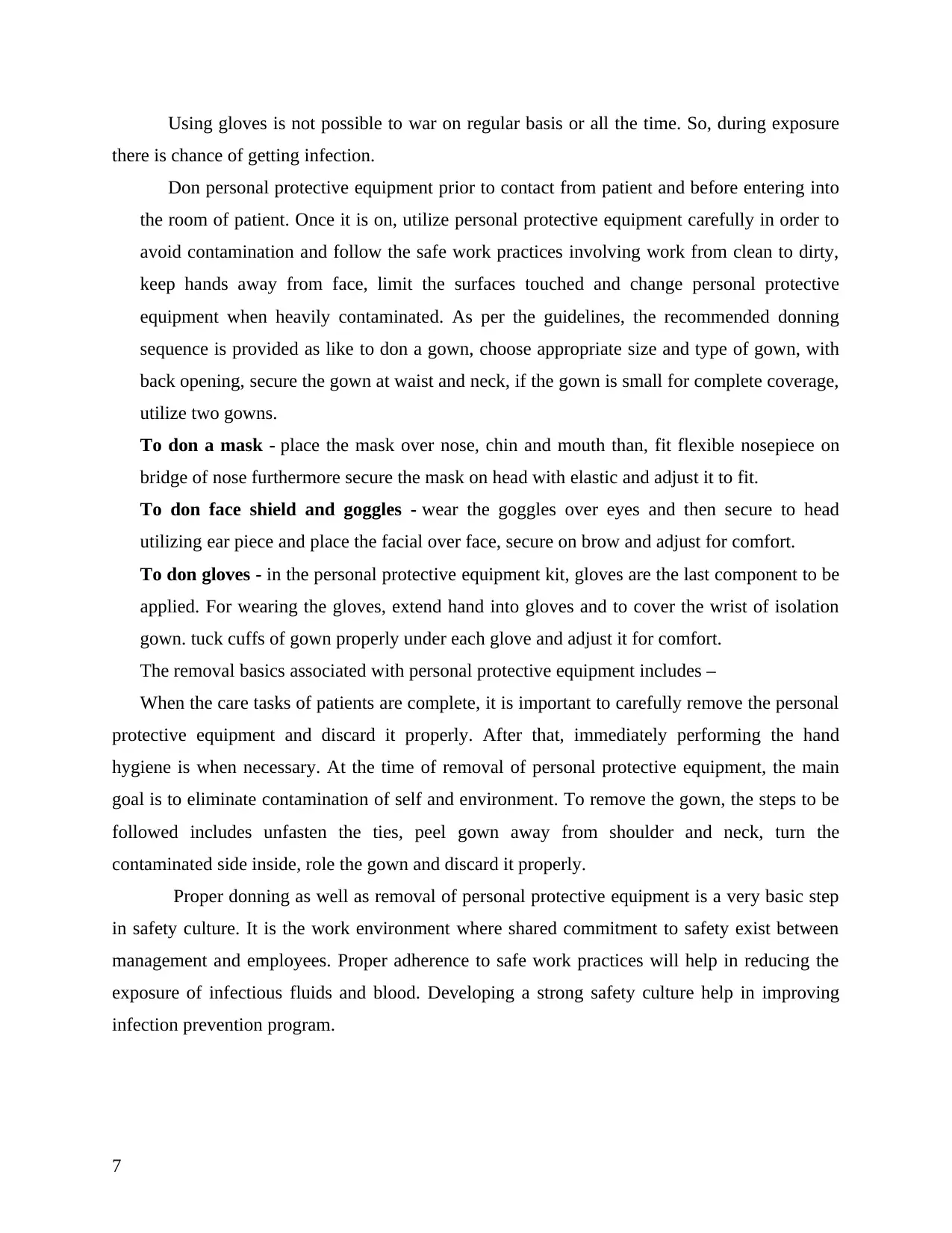
Using gloves is not possible to war on regular basis or all the time. So, during exposure
there is chance of getting infection.
Don personal protective equipment prior to contact from patient and before entering into
the room of patient. Once it is on, utilize personal protective equipment carefully in order to
avoid contamination and follow the safe work practices involving work from clean to dirty,
keep hands away from face, limit the surfaces touched and change personal protective
equipment when heavily contaminated. As per the guidelines, the recommended donning
sequence is provided as like to don a gown, choose appropriate size and type of gown, with
back opening, secure the gown at waist and neck, if the gown is small for complete coverage,
utilize two gowns.
To don a mask - place the mask over nose, chin and mouth than, fit flexible nosepiece on
bridge of nose furthermore secure the mask on head with elastic and adjust it to fit.
To don face shield and goggles - wear the goggles over eyes and then secure to head
utilizing ear piece and place the facial over face, secure on brow and adjust for comfort.
To don gloves - in the personal protective equipment kit, gloves are the last component to be
applied. For wearing the gloves, extend hand into gloves and to cover the wrist of isolation
gown. tuck cuffs of gown properly under each glove and adjust it for comfort.
The removal basics associated with personal protective equipment includes –
When the care tasks of patients are complete, it is important to carefully remove the personal
protective equipment and discard it properly. After that, immediately performing the hand
hygiene is when necessary. At the time of removal of personal protective equipment, the main
goal is to eliminate contamination of self and environment. To remove the gown, the steps to be
followed includes unfasten the ties, peel gown away from shoulder and neck, turn the
contaminated side inside, role the gown and discard it properly.
Proper donning as well as removal of personal protective equipment is a very basic step
in safety culture. It is the work environment where shared commitment to safety exist between
management and employees. Proper adherence to safe work practices will help in reducing the
exposure of infectious fluids and blood. Developing a strong safety culture help in improving
infection prevention program.
7
there is chance of getting infection.
Don personal protective equipment prior to contact from patient and before entering into
the room of patient. Once it is on, utilize personal protective equipment carefully in order to
avoid contamination and follow the safe work practices involving work from clean to dirty,
keep hands away from face, limit the surfaces touched and change personal protective
equipment when heavily contaminated. As per the guidelines, the recommended donning
sequence is provided as like to don a gown, choose appropriate size and type of gown, with
back opening, secure the gown at waist and neck, if the gown is small for complete coverage,
utilize two gowns.
To don a mask - place the mask over nose, chin and mouth than, fit flexible nosepiece on
bridge of nose furthermore secure the mask on head with elastic and adjust it to fit.
To don face shield and goggles - wear the goggles over eyes and then secure to head
utilizing ear piece and place the facial over face, secure on brow and adjust for comfort.
To don gloves - in the personal protective equipment kit, gloves are the last component to be
applied. For wearing the gloves, extend hand into gloves and to cover the wrist of isolation
gown. tuck cuffs of gown properly under each glove and adjust it for comfort.
The removal basics associated with personal protective equipment includes –
When the care tasks of patients are complete, it is important to carefully remove the personal
protective equipment and discard it properly. After that, immediately performing the hand
hygiene is when necessary. At the time of removal of personal protective equipment, the main
goal is to eliminate contamination of self and environment. To remove the gown, the steps to be
followed includes unfasten the ties, peel gown away from shoulder and neck, turn the
contaminated side inside, role the gown and discard it properly.
Proper donning as well as removal of personal protective equipment is a very basic step
in safety culture. It is the work environment where shared commitment to safety exist between
management and employees. Proper adherence to safe work practices will help in reducing the
exposure of infectious fluids and blood. Developing a strong safety culture help in improving
infection prevention program.
7
Paraphrase This Document
Need a fresh take? Get an instant paraphrase of this document with our AI Paraphraser
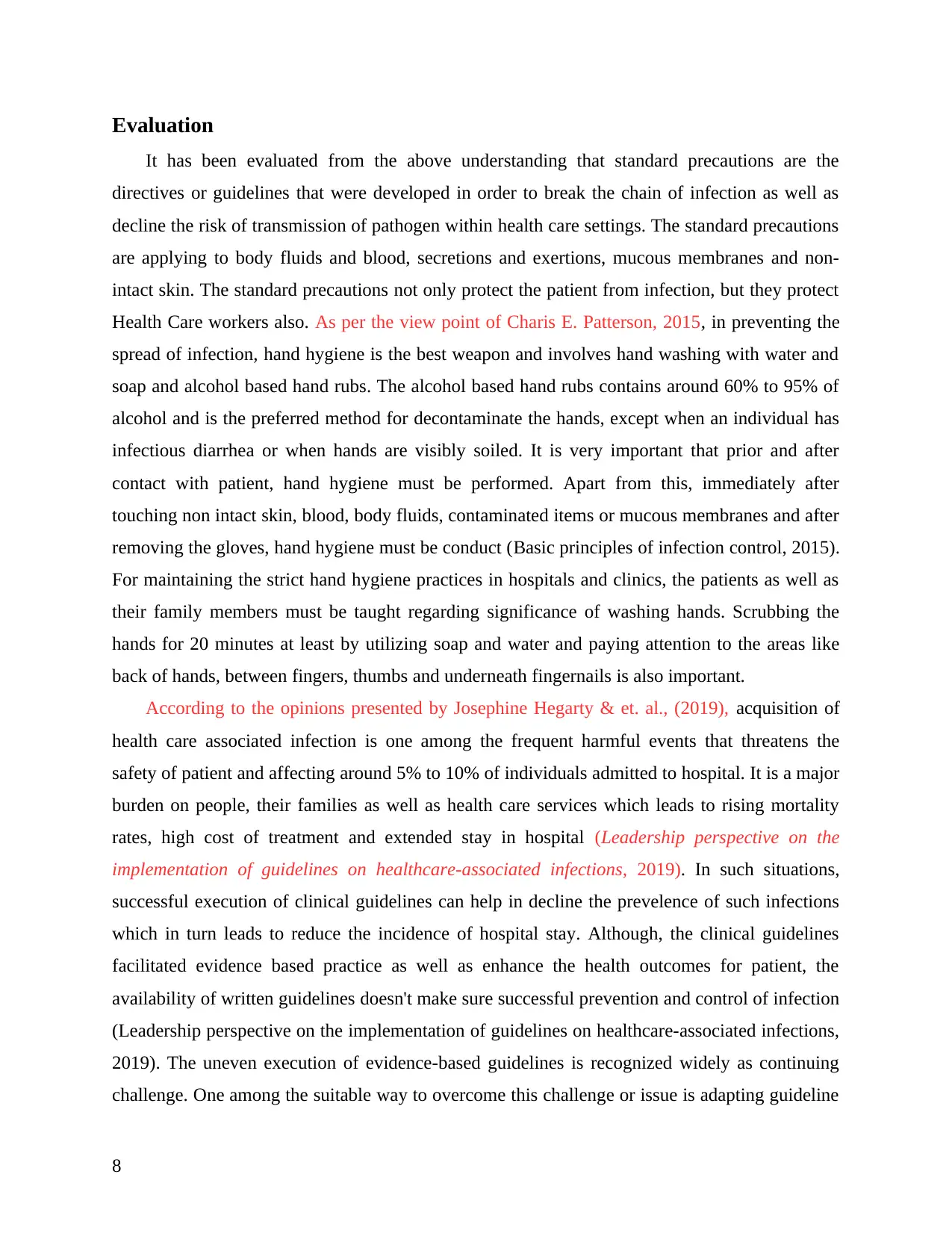
Evaluation
It has been evaluated from the above understanding that standard precautions are the
directives or guidelines that were developed in order to break the chain of infection as well as
decline the risk of transmission of pathogen within health care settings. The standard precautions
are applying to body fluids and blood, secretions and exertions, mucous membranes and non-
intact skin. The standard precautions not only protect the patient from infection, but they protect
Health Care workers also. As per the view point of Charis E. Patterson, 2015, in preventing the
spread of infection, hand hygiene is the best weapon and involves hand washing with water and
soap and alcohol based hand rubs. The alcohol based hand rubs contains around 60% to 95% of
alcohol and is the preferred method for decontaminate the hands, except when an individual has
infectious diarrhea or when hands are visibly soiled. It is very important that prior and after
contact with patient, hand hygiene must be performed. Apart from this, immediately after
touching non intact skin, blood, body fluids, contaminated items or mucous membranes and after
removing the gloves, hand hygiene must be conduct (Basic principles of infection control, 2015).
For maintaining the strict hand hygiene practices in hospitals and clinics, the patients as well as
their family members must be taught regarding significance of washing hands. Scrubbing the
hands for 20 minutes at least by utilizing soap and water and paying attention to the areas like
back of hands, between fingers, thumbs and underneath fingernails is also important.
According to the opinions presented by Josephine Hegarty & et. al., (2019), acquisition of
health care associated infection is one among the frequent harmful events that threatens the
safety of patient and affecting around 5% to 10% of individuals admitted to hospital. It is a major
burden on people, their families as well as health care services which leads to rising mortality
rates, high cost of treatment and extended stay in hospital (Leadership perspective on the
implementation of guidelines on healthcare-associated infections, 2019). In such situations,
successful execution of clinical guidelines can help in decline the prevelence of such infections
which in turn leads to reduce the incidence of hospital stay. Although, the clinical guidelines
facilitated evidence based practice as well as enhance the health outcomes for patient, the
availability of written guidelines doesn't make sure successful prevention and control of infection
(Leadership perspective on the implementation of guidelines on healthcare-associated infections,
2019). The uneven execution of evidence-based guidelines is recognized widely as continuing
challenge. One among the suitable way to overcome this challenge or issue is adapting guideline
8
It has been evaluated from the above understanding that standard precautions are the
directives or guidelines that were developed in order to break the chain of infection as well as
decline the risk of transmission of pathogen within health care settings. The standard precautions
are applying to body fluids and blood, secretions and exertions, mucous membranes and non-
intact skin. The standard precautions not only protect the patient from infection, but they protect
Health Care workers also. As per the view point of Charis E. Patterson, 2015, in preventing the
spread of infection, hand hygiene is the best weapon and involves hand washing with water and
soap and alcohol based hand rubs. The alcohol based hand rubs contains around 60% to 95% of
alcohol and is the preferred method for decontaminate the hands, except when an individual has
infectious diarrhea or when hands are visibly soiled. It is very important that prior and after
contact with patient, hand hygiene must be performed. Apart from this, immediately after
touching non intact skin, blood, body fluids, contaminated items or mucous membranes and after
removing the gloves, hand hygiene must be conduct (Basic principles of infection control, 2015).
For maintaining the strict hand hygiene practices in hospitals and clinics, the patients as well as
their family members must be taught regarding significance of washing hands. Scrubbing the
hands for 20 minutes at least by utilizing soap and water and paying attention to the areas like
back of hands, between fingers, thumbs and underneath fingernails is also important.
According to the opinions presented by Josephine Hegarty & et. al., (2019), acquisition of
health care associated infection is one among the frequent harmful events that threatens the
safety of patient and affecting around 5% to 10% of individuals admitted to hospital. It is a major
burden on people, their families as well as health care services which leads to rising mortality
rates, high cost of treatment and extended stay in hospital (Leadership perspective on the
implementation of guidelines on healthcare-associated infections, 2019). In such situations,
successful execution of clinical guidelines can help in decline the prevelence of such infections
which in turn leads to reduce the incidence of hospital stay. Although, the clinical guidelines
facilitated evidence based practice as well as enhance the health outcomes for patient, the
availability of written guidelines doesn't make sure successful prevention and control of infection
(Leadership perspective on the implementation of guidelines on healthcare-associated infections,
2019). The uneven execution of evidence-based guidelines is recognized widely as continuing
challenge. One among the suitable way to overcome this challenge or issue is adapting guideline
8
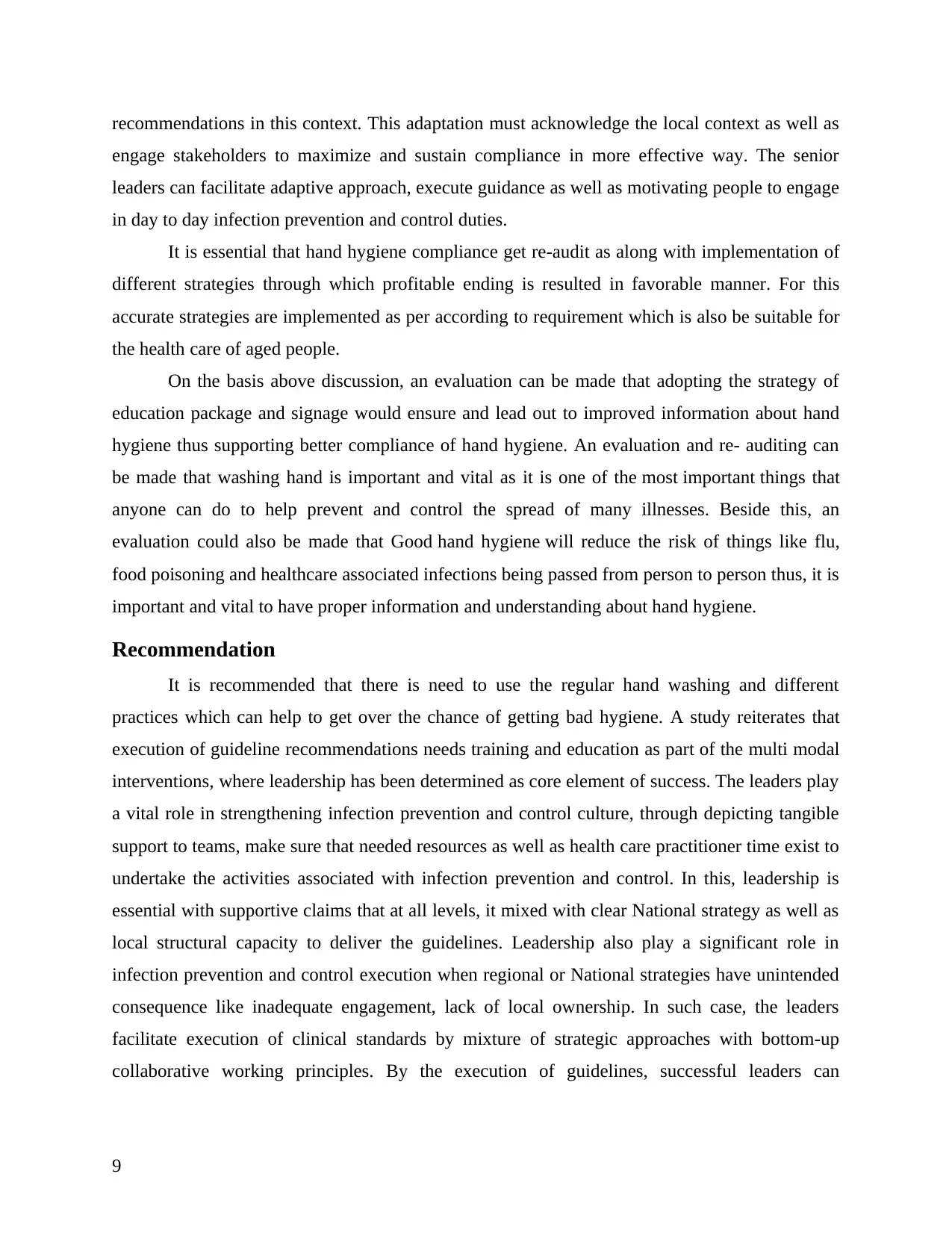
recommendations in this context. This adaptation must acknowledge the local context as well as
engage stakeholders to maximize and sustain compliance in more effective way. The senior
leaders can facilitate adaptive approach, execute guidance as well as motivating people to engage
in day to day infection prevention and control duties.
It is essential that hand hygiene compliance get re-audit as along with implementation of
different strategies through which profitable ending is resulted in favorable manner. For this
accurate strategies are implemented as per according to requirement which is also be suitable for
the health care of aged people.
On the basis above discussion, an evaluation can be made that adopting the strategy of
education package and signage would ensure and lead out to improved information about hand
hygiene thus supporting better compliance of hand hygiene. An evaluation and re- auditing can
be made that washing hand is important and vital as it is one of the most important things that
anyone can do to help prevent and control the spread of many illnesses. Beside this, an
evaluation could also be made that Good hand hygiene will reduce the risk of things like flu,
food poisoning and healthcare associated infections being passed from person to person thus, it is
important and vital to have proper information and understanding about hand hygiene.
Recommendation
It is recommended that there is need to use the regular hand washing and different
practices which can help to get over the chance of getting bad hygiene. A study reiterates that
execution of guideline recommendations needs training and education as part of the multi modal
interventions, where leadership has been determined as core element of success. The leaders play
a vital role in strengthening infection prevention and control culture, through depicting tangible
support to teams, make sure that needed resources as well as health care practitioner time exist to
undertake the activities associated with infection prevention and control. In this, leadership is
essential with supportive claims that at all levels, it mixed with clear National strategy as well as
local structural capacity to deliver the guidelines. Leadership also play a significant role in
infection prevention and control execution when regional or National strategies have unintended
consequence like inadequate engagement, lack of local ownership. In such case, the leaders
facilitate execution of clinical standards by mixture of strategic approaches with bottom-up
collaborative working principles. By the execution of guidelines, successful leaders can
9
engage stakeholders to maximize and sustain compliance in more effective way. The senior
leaders can facilitate adaptive approach, execute guidance as well as motivating people to engage
in day to day infection prevention and control duties.
It is essential that hand hygiene compliance get re-audit as along with implementation of
different strategies through which profitable ending is resulted in favorable manner. For this
accurate strategies are implemented as per according to requirement which is also be suitable for
the health care of aged people.
On the basis above discussion, an evaluation can be made that adopting the strategy of
education package and signage would ensure and lead out to improved information about hand
hygiene thus supporting better compliance of hand hygiene. An evaluation and re- auditing can
be made that washing hand is important and vital as it is one of the most important things that
anyone can do to help prevent and control the spread of many illnesses. Beside this, an
evaluation could also be made that Good hand hygiene will reduce the risk of things like flu,
food poisoning and healthcare associated infections being passed from person to person thus, it is
important and vital to have proper information and understanding about hand hygiene.
Recommendation
It is recommended that there is need to use the regular hand washing and different
practices which can help to get over the chance of getting bad hygiene. A study reiterates that
execution of guideline recommendations needs training and education as part of the multi modal
interventions, where leadership has been determined as core element of success. The leaders play
a vital role in strengthening infection prevention and control culture, through depicting tangible
support to teams, make sure that needed resources as well as health care practitioner time exist to
undertake the activities associated with infection prevention and control. In this, leadership is
essential with supportive claims that at all levels, it mixed with clear National strategy as well as
local structural capacity to deliver the guidelines. Leadership also play a significant role in
infection prevention and control execution when regional or National strategies have unintended
consequence like inadequate engagement, lack of local ownership. In such case, the leaders
facilitate execution of clinical standards by mixture of strategic approaches with bottom-up
collaborative working principles. By the execution of guidelines, successful leaders can
9
⊘ This is a preview!⊘
Do you want full access?
Subscribe today to unlock all pages.

Trusted by 1+ million students worldwide
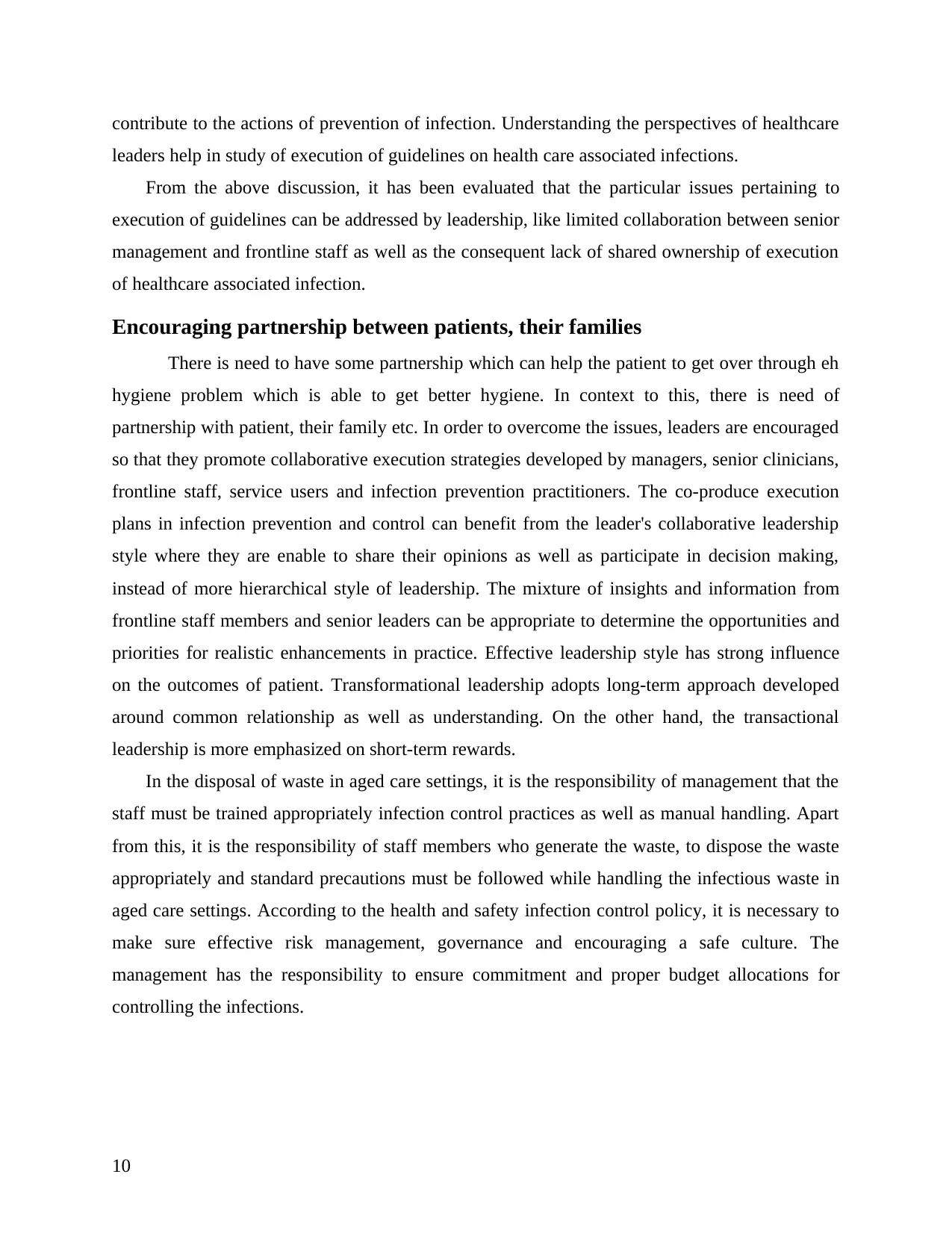
contribute to the actions of prevention of infection. Understanding the perspectives of healthcare
leaders help in study of execution of guidelines on health care associated infections.
From the above discussion, it has been evaluated that the particular issues pertaining to
execution of guidelines can be addressed by leadership, like limited collaboration between senior
management and frontline staff as well as the consequent lack of shared ownership of execution
of healthcare associated infection.
Encouraging partnership between patients, their families
There is need to have some partnership which can help the patient to get over through eh
hygiene problem which is able to get better hygiene. In context to this, there is need of
partnership with patient, their family etc. In order to overcome the issues, leaders are encouraged
so that they promote collaborative execution strategies developed by managers, senior clinicians,
frontline staff, service users and infection prevention practitioners. The co-produce execution
plans in infection prevention and control can benefit from the leader's collaborative leadership
style where they are enable to share their opinions as well as participate in decision making,
instead of more hierarchical style of leadership. The mixture of insights and information from
frontline staff members and senior leaders can be appropriate to determine the opportunities and
priorities for realistic enhancements in practice. Effective leadership style has strong influence
on the outcomes of patient. Transformational leadership adopts long-term approach developed
around common relationship as well as understanding. On the other hand, the transactional
leadership is more emphasized on short-term rewards.
In the disposal of waste in aged care settings, it is the responsibility of management that the
staff must be trained appropriately infection control practices as well as manual handling. Apart
from this, it is the responsibility of staff members who generate the waste, to dispose the waste
appropriately and standard precautions must be followed while handling the infectious waste in
aged care settings. According to the health and safety infection control policy, it is necessary to
make sure effective risk management, governance and encouraging a safe culture. The
management has the responsibility to ensure commitment and proper budget allocations for
controlling the infections.
10
leaders help in study of execution of guidelines on health care associated infections.
From the above discussion, it has been evaluated that the particular issues pertaining to
execution of guidelines can be addressed by leadership, like limited collaboration between senior
management and frontline staff as well as the consequent lack of shared ownership of execution
of healthcare associated infection.
Encouraging partnership between patients, their families
There is need to have some partnership which can help the patient to get over through eh
hygiene problem which is able to get better hygiene. In context to this, there is need of
partnership with patient, their family etc. In order to overcome the issues, leaders are encouraged
so that they promote collaborative execution strategies developed by managers, senior clinicians,
frontline staff, service users and infection prevention practitioners. The co-produce execution
plans in infection prevention and control can benefit from the leader's collaborative leadership
style where they are enable to share their opinions as well as participate in decision making,
instead of more hierarchical style of leadership. The mixture of insights and information from
frontline staff members and senior leaders can be appropriate to determine the opportunities and
priorities for realistic enhancements in practice. Effective leadership style has strong influence
on the outcomes of patient. Transformational leadership adopts long-term approach developed
around common relationship as well as understanding. On the other hand, the transactional
leadership is more emphasized on short-term rewards.
In the disposal of waste in aged care settings, it is the responsibility of management that the
staff must be trained appropriately infection control practices as well as manual handling. Apart
from this, it is the responsibility of staff members who generate the waste, to dispose the waste
appropriately and standard precautions must be followed while handling the infectious waste in
aged care settings. According to the health and safety infection control policy, it is necessary to
make sure effective risk management, governance and encouraging a safe culture. The
management has the responsibility to ensure commitment and proper budget allocations for
controlling the infections.
10
Paraphrase This Document
Need a fresh take? Get an instant paraphrase of this document with our AI Paraphraser
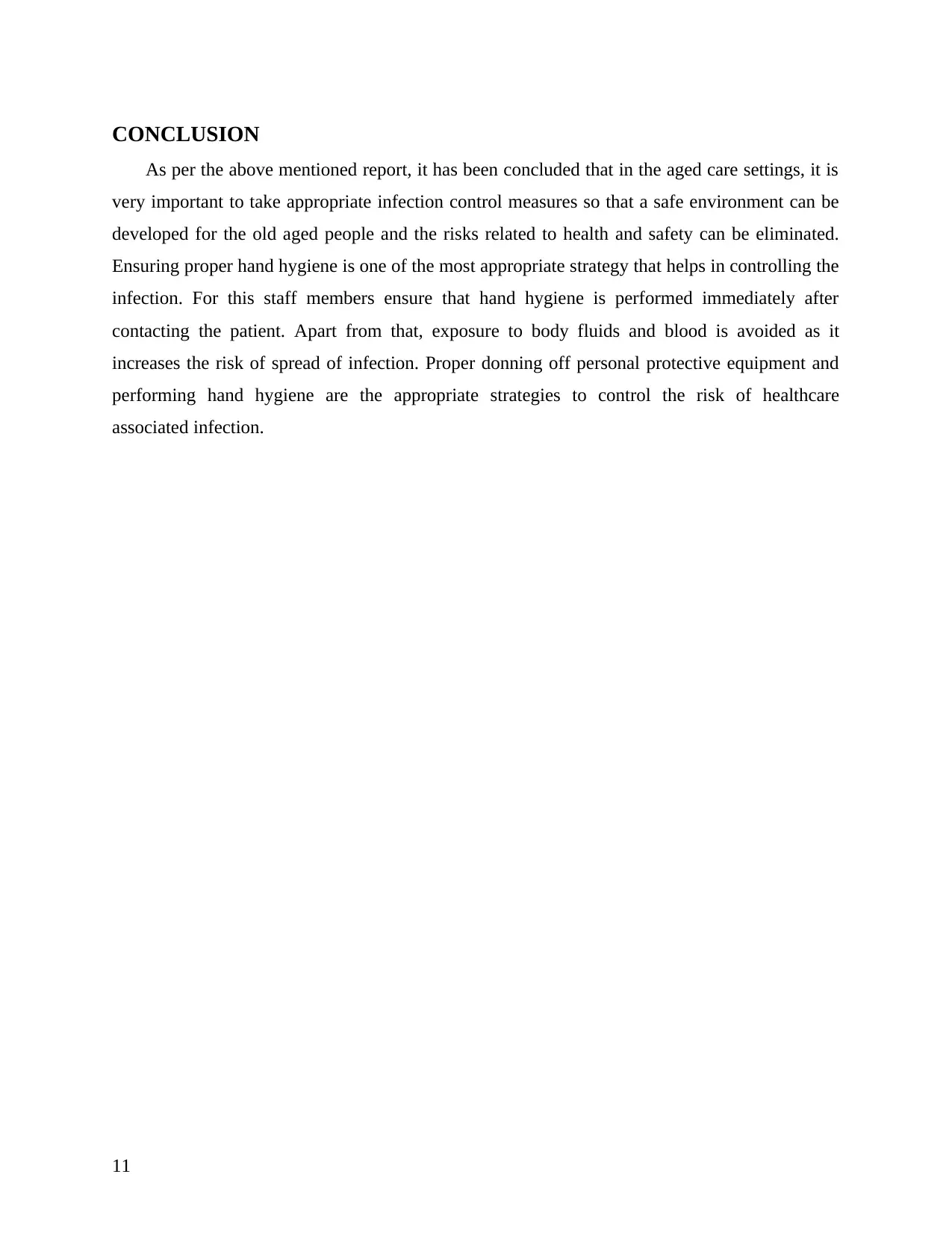
CONCLUSION
As per the above mentioned report, it has been concluded that in the aged care settings, it is
very important to take appropriate infection control measures so that a safe environment can be
developed for the old aged people and the risks related to health and safety can be eliminated.
Ensuring proper hand hygiene is one of the most appropriate strategy that helps in controlling the
infection. For this staff members ensure that hand hygiene is performed immediately after
contacting the patient. Apart from that, exposure to body fluids and blood is avoided as it
increases the risk of spread of infection. Proper donning off personal protective equipment and
performing hand hygiene are the appropriate strategies to control the risk of healthcare
associated infection.
11
As per the above mentioned report, it has been concluded that in the aged care settings, it is
very important to take appropriate infection control measures so that a safe environment can be
developed for the old aged people and the risks related to health and safety can be eliminated.
Ensuring proper hand hygiene is one of the most appropriate strategy that helps in controlling the
infection. For this staff members ensure that hand hygiene is performed immediately after
contacting the patient. Apart from that, exposure to body fluids and blood is avoided as it
increases the risk of spread of infection. Proper donning off personal protective equipment and
performing hand hygiene are the appropriate strategies to control the risk of healthcare
associated infection.
11
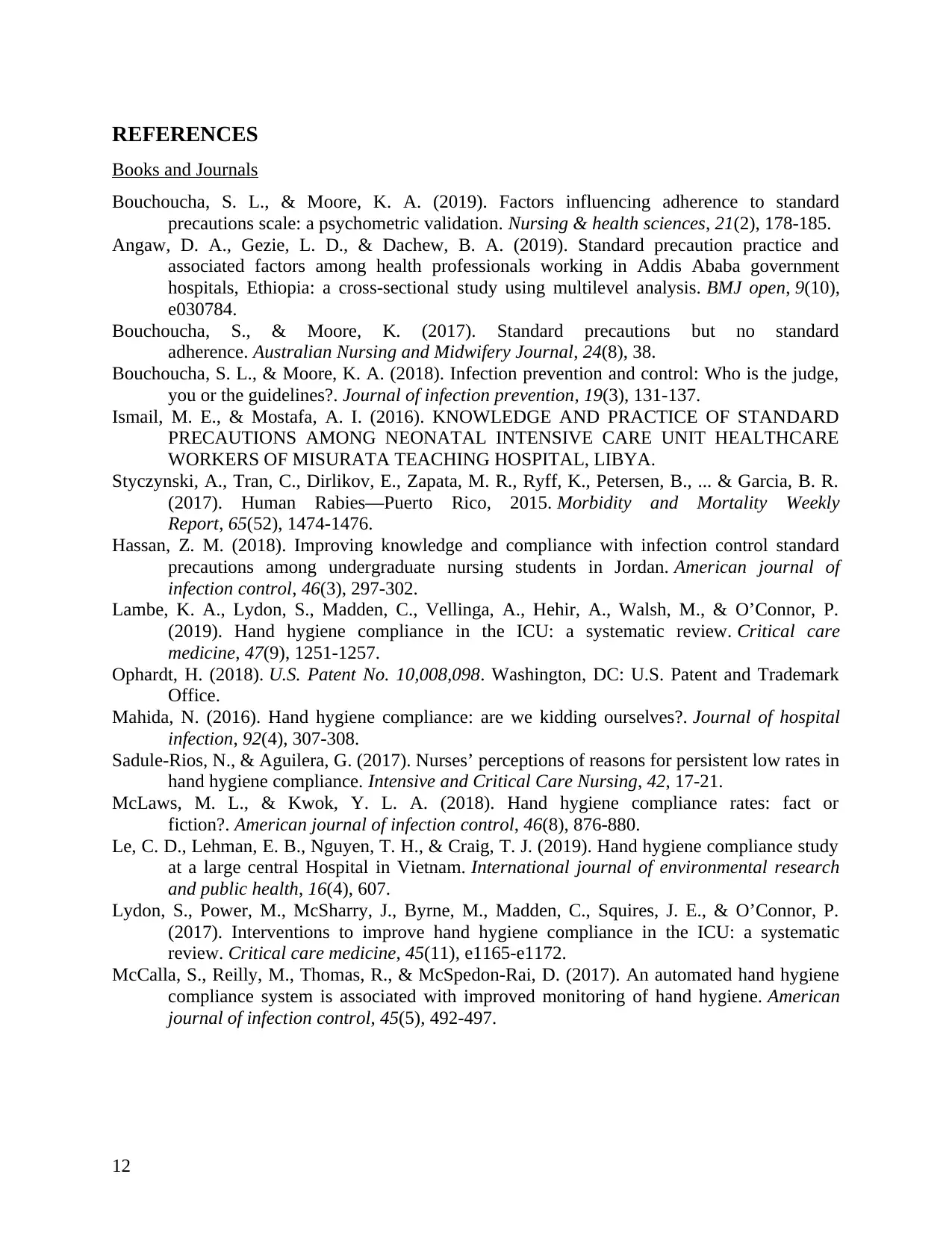
REFERENCES
Books and Journals
Bouchoucha, S. L., & Moore, K. A. (2019). Factors influencing adherence to standard
precautions scale: a psychometric validation. Nursing & health sciences, 21(2), 178-185.
Angaw, D. A., Gezie, L. D., & Dachew, B. A. (2019). Standard precaution practice and
associated factors among health professionals working in Addis Ababa government
hospitals, Ethiopia: a cross-sectional study using multilevel analysis. BMJ open, 9(10),
e030784.
Bouchoucha, S., & Moore, K. (2017). Standard precautions but no standard
adherence. Australian Nursing and Midwifery Journal, 24(8), 38.
Bouchoucha, S. L., & Moore, K. A. (2018). Infection prevention and control: Who is the judge,
you or the guidelines?. Journal of infection prevention, 19(3), 131-137.
Ismail, M. E., & Mostafa, A. I. (2016). KNOWLEDGE AND PRACTICE OF STANDARD
PRECAUTIONS AMONG NEONATAL INTENSIVE CARE UNIT HEALTHCARE
WORKERS OF MISURATA TEACHING HOSPITAL, LIBYA.
Styczynski, A., Tran, C., Dirlikov, E., Zapata, M. R., Ryff, K., Petersen, B., ... & Garcia, B. R.
(2017). Human Rabies—Puerto Rico, 2015. Morbidity and Mortality Weekly
Report, 65(52), 1474-1476.
Hassan, Z. M. (2018). Improving knowledge and compliance with infection control standard
precautions among undergraduate nursing students in Jordan. American journal of
infection control, 46(3), 297-302.
Lambe, K. A., Lydon, S., Madden, C., Vellinga, A., Hehir, A., Walsh, M., & O’Connor, P.
(2019). Hand hygiene compliance in the ICU: a systematic review. Critical care
medicine, 47(9), 1251-1257.
Ophardt, H. (2018). U.S. Patent No. 10,008,098. Washington, DC: U.S. Patent and Trademark
Office.
Mahida, N. (2016). Hand hygiene compliance: are we kidding ourselves?. Journal of hospital
infection, 92(4), 307-308.
Sadule-Rios, N., & Aguilera, G. (2017). Nurses’ perceptions of reasons for persistent low rates in
hand hygiene compliance. Intensive and Critical Care Nursing, 42, 17-21.
McLaws, M. L., & Kwok, Y. L. A. (2018). Hand hygiene compliance rates: fact or
fiction?. American journal of infection control, 46(8), 876-880.
Le, C. D., Lehman, E. B., Nguyen, T. H., & Craig, T. J. (2019). Hand hygiene compliance study
at a large central Hospital in Vietnam. International journal of environmental research
and public health, 16(4), 607.
Lydon, S., Power, M., McSharry, J., Byrne, M., Madden, C., Squires, J. E., & O’Connor, P.
(2017). Interventions to improve hand hygiene compliance in the ICU: a systematic
review. Critical care medicine, 45(11), e1165-e1172.
McCalla, S., Reilly, M., Thomas, R., & McSpedon-Rai, D. (2017). An automated hand hygiene
compliance system is associated with improved monitoring of hand hygiene. American
journal of infection control, 45(5), 492-497.
12
Books and Journals
Bouchoucha, S. L., & Moore, K. A. (2019). Factors influencing adherence to standard
precautions scale: a psychometric validation. Nursing & health sciences, 21(2), 178-185.
Angaw, D. A., Gezie, L. D., & Dachew, B. A. (2019). Standard precaution practice and
associated factors among health professionals working in Addis Ababa government
hospitals, Ethiopia: a cross-sectional study using multilevel analysis. BMJ open, 9(10),
e030784.
Bouchoucha, S., & Moore, K. (2017). Standard precautions but no standard
adherence. Australian Nursing and Midwifery Journal, 24(8), 38.
Bouchoucha, S. L., & Moore, K. A. (2018). Infection prevention and control: Who is the judge,
you or the guidelines?. Journal of infection prevention, 19(3), 131-137.
Ismail, M. E., & Mostafa, A. I. (2016). KNOWLEDGE AND PRACTICE OF STANDARD
PRECAUTIONS AMONG NEONATAL INTENSIVE CARE UNIT HEALTHCARE
WORKERS OF MISURATA TEACHING HOSPITAL, LIBYA.
Styczynski, A., Tran, C., Dirlikov, E., Zapata, M. R., Ryff, K., Petersen, B., ... & Garcia, B. R.
(2017). Human Rabies—Puerto Rico, 2015. Morbidity and Mortality Weekly
Report, 65(52), 1474-1476.
Hassan, Z. M. (2018). Improving knowledge and compliance with infection control standard
precautions among undergraduate nursing students in Jordan. American journal of
infection control, 46(3), 297-302.
Lambe, K. A., Lydon, S., Madden, C., Vellinga, A., Hehir, A., Walsh, M., & O’Connor, P.
(2019). Hand hygiene compliance in the ICU: a systematic review. Critical care
medicine, 47(9), 1251-1257.
Ophardt, H. (2018). U.S. Patent No. 10,008,098. Washington, DC: U.S. Patent and Trademark
Office.
Mahida, N. (2016). Hand hygiene compliance: are we kidding ourselves?. Journal of hospital
infection, 92(4), 307-308.
Sadule-Rios, N., & Aguilera, G. (2017). Nurses’ perceptions of reasons for persistent low rates in
hand hygiene compliance. Intensive and Critical Care Nursing, 42, 17-21.
McLaws, M. L., & Kwok, Y. L. A. (2018). Hand hygiene compliance rates: fact or
fiction?. American journal of infection control, 46(8), 876-880.
Le, C. D., Lehman, E. B., Nguyen, T. H., & Craig, T. J. (2019). Hand hygiene compliance study
at a large central Hospital in Vietnam. International journal of environmental research
and public health, 16(4), 607.
Lydon, S., Power, M., McSharry, J., Byrne, M., Madden, C., Squires, J. E., & O’Connor, P.
(2017). Interventions to improve hand hygiene compliance in the ICU: a systematic
review. Critical care medicine, 45(11), e1165-e1172.
McCalla, S., Reilly, M., Thomas, R., & McSpedon-Rai, D. (2017). An automated hand hygiene
compliance system is associated with improved monitoring of hand hygiene. American
journal of infection control, 45(5), 492-497.
12
⊘ This is a preview!⊘
Do you want full access?
Subscribe today to unlock all pages.

Trusted by 1+ million students worldwide
1 out of 13
Related Documents
Your All-in-One AI-Powered Toolkit for Academic Success.
+13062052269
info@desklib.com
Available 24*7 on WhatsApp / Email
![[object Object]](/_next/static/media/star-bottom.7253800d.svg)
Unlock your academic potential
Copyright © 2020–2025 A2Z Services. All Rights Reserved. Developed and managed by ZUCOL.





